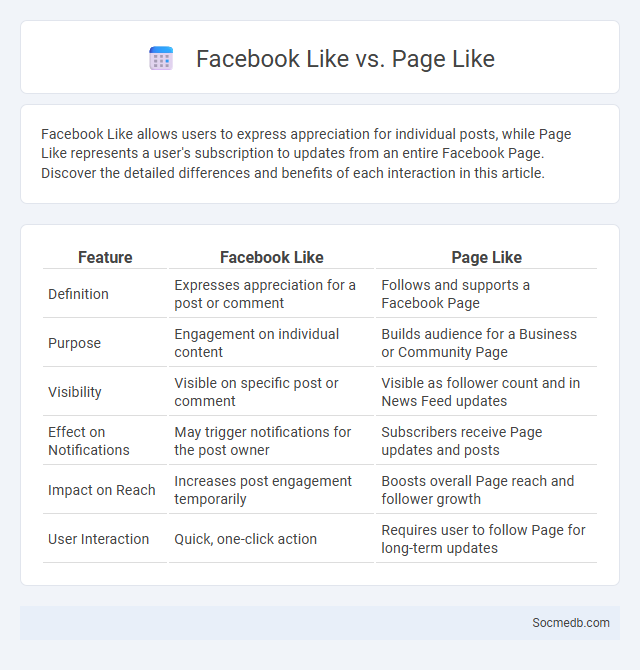
Photo illustration: Facebook Like vs Page Like
Facebook Like allows users to express appreciation for individual posts, while Page Like represents a user's subscription to updates from an entire Facebook Page. Discover the detailed differences and benefits of each interaction in this article.
Table of Comparison
| Feature | Facebook Like | Page Like |
|---|---|---|
| Definition | Expresses appreciation for a post or comment | Follows and supports a Facebook Page |
| Purpose | Engagement on individual content | Builds audience for a Business or Community Page |
| Visibility | Visible on specific post or comment | Visible as follower count and in News Feed updates |
| Effect on Notifications | May trigger notifications for the post owner | Subscribers receive Page updates and posts |
| Impact on Reach | Increases post engagement temporarily | Boosts overall Page reach and follower growth |
| User Interaction | Quick, one-click action | Requires user to follow Page for long-term updates |
Understanding Facebook Likes: An Overview
Facebook Likes measure user engagement by indicating approval or interest in your content, helping you gauge audience preferences. These interactions influence the visibility of your posts through Facebook's algorithm, affecting organic reach and potential growth. Tracking Like patterns enables you to optimize content strategy for increased user interaction and brand awareness.
What is a Facebook Page Like?
A Facebook Page Like represents a user's endorsement and interest in a brand, business, or public figure, increasing the page's visibility and social proof. Your Facebook Page's total likes influence organic reach, engagement rates, and help attract targeted audiences for marketing campaigns. Tracking and analyzing Page Likes provides valuable insights into audience demographics and content preferences for optimized social media strategies.
What is a Facebook Post Like?
A Facebook post is a versatile digital content format used for sharing text, images, videos, and links, designed to engage friends, followers, or the public depending on privacy settings. It typically includes interactive elements such as likes, comments, and shares, facilitating social interaction and content dissemination. Brands and individuals leverage Facebook posts to enhance visibility, communicate messages, and drive traffic to websites or profiles, optimizing reach through tailored captions and multimedia integration.
Key Differences: Page Like vs Post Like
Page Likes indicate the total number of users who follow or endorse your social media profile, providing a measure of your overall audience size and brand reach. Post Likes represent user engagement with individual content pieces, reflecting the immediate popularity and relevance of specific posts. Understanding the distinction between Page Likes and Post Likes helps you analyze both your long-term community growth and the effectiveness of your content strategy.
Impact of Page Likes on Brand Reach
Page likes on social media significantly enhance brand reach by increasing the visibility of posts to a wider audience through organic algorithms. Higher numbers of page likes improve social proof, fostering trust and encouraging more user engagement and sharing. Brands with substantial page likes benefit from better targeting opportunities in paid campaigns, leading to more effective audience growth and customer acquisition.
Engagement Metrics: How Post Likes Matter
Post likes serve as a key engagement metric on social media platforms, directly reflecting user interest and content relevance. High like counts increase post visibility through platform algorithms, enhancing reach and potential follower growth. Analyzing likes alongside comments and shares provides comprehensive insights into audience preferences and content effectiveness.
Algorithm Effects: Page Like vs Post Like
Social media algorithms prioritize content based on user engagement signals, with post likes offering more immediate relevance than page likes. Post likes directly influence the visibility of specific updates, boosting reach and interaction within networks. In contrast, page likes signal broader interest but have less impact on the distribution of individual posts.
Building Strategy: When to Focus on Page Likes
Focusing on page likes is crucial during the initial phase of building a social media presence to establish brand credibility and expand reach. Targeting a specific audience through demographic and interest-based campaigns enhances the quality of likes, increasing potential engagement and conversions. Measuring engagement rates alongside page likes ensures that the growing audience is actively interested, supporting sustainable long-term strategy development.
Boosting Engagement: Maximizing Post Likes
Boosting engagement on social media relies on crafting visually appealing content paired with compelling captions that encourage interaction, such as questions or calls to action. Posting consistently during peak activity hours increases the visibility of your content to your audience, maximizing post likes and overall engagement. Utilizing relevant hashtags and engaging with your followers through comments strengthens community ties and drives more meaningful interactions.
Choosing the Right Metric: Page Like vs Post Like vs Like
Choosing the right metric for social media success depends on your specific goals and audience engagement. Page Likes reflect overall brand popularity and potential reach, while Post Likes indicate the immediate reaction to specific content and engagement quality. Your strategy should prioritize Post Likes to measure content effectiveness, while Page Likes help track long-term audience growth and brand loyalty.
 socmedb.com
socmedb.com